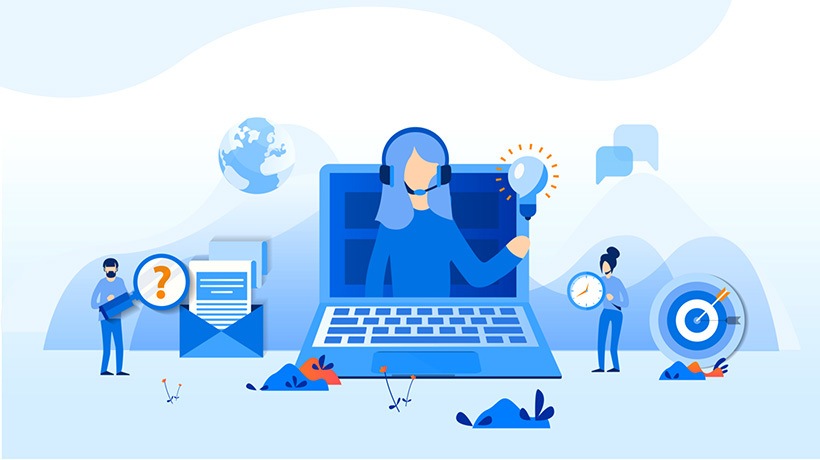Perks Of Scenario-Based Learning For Customer Service Training
The most successful customer service training programs focus a great deal of their content around experiential learning because it significantly increases employee performance and customer satisfaction. Experiential learning methods focus on having employees learn new skills by experience and practicing them. Some experiential training methods include job aids like posters and PDFs, coaching, or role-playing different workplace scenarios with team members.
One of the most popular forms of experiential training is scenario-based learning. This method of customer service training creates life-like situations that employees might encounter on the job yielding high-quality results. The simulation walks them through the different choices they can make, which leads to different outcomes. Employees use critical thinking skills to choose responses, solve problems and deliver great customer service experiences. This form of training is usually completed on an eLearning platform where employees can practice the skills they learn in a risk-free environment.
Simulations can be used for different types of customer service training, from soft skills to product knowledge. Simulations are able to provide enough context to help employees better understand how to apply what they learn on the job. There are numerous benefits that simulations provide to both employees and their employers, including the following:
Increases Learner Engagement
One of the most valuable benefits of scenario-based learning is its ability to engage learners by stimulating their brain activity. This form of learning encourages learners to think critically allowing them to solve problems that make decisions based on what they have learned. Storytelling simulations are a great way to promote engagement as it stimulates learner's emotions. If employees are invested in the story told by the simulation, they are less likely to become distracted.
Increases Knowledge Retention
Simulations increase knowledge retention in many ways. The use of storytelling makes the content easier to understand and remember. Today's learners demand engaging content and used to absorb information in small amounts at a time. Simulations are also usually broken down into short, simple modules that focus on one specific topic at a time, much like the way we look up short videos or articles online. Learners also practice what they learn during simulations. The combination of storytelling and practice increases knowledge retention because people learn the most through their experiences.
Speeds Up Time To Competency
Another advantage of scenario-based learning is that employees can learn new skills faster. Simulations can be done alone and can be worked through in minutes. This makes the process much faster than real-time interactions with customers. Simulations speed up the time to competency by allowing employees to practice their skills in a quick and efficient way.
Improves Knowledge Application
Employees who practice what they learn in simulations are more likely to apply that knowledge in real life than they would after participating in other forms of training. It allows employees to practice a new skill in a risk-free environment helping them to build confidence before interacting with customers. Simulations provide examples and show employees how the information they are learning is useful and how they can apply it on the job.
Allows Employees To Fail & Learn
Simulations are mostly conducted in an online environment, making them risk-free. This takes quite a bit of pressure off the learner. If they do not get a particular question or scenario just right, they can go back and see what they can do differently next time. Enabling employees to learn and grow in this manner is both engaging and effective. They will learn more than just the right answers, they will understand why that answer is the best option.
Builds Employee Confidence
Most of the time, customer representatives work with customers who are frustrated because of the issues. This can be an intimidating task without the right experience. Simulations provide employees with the experience they need to build confidence and give options they can choose when handling a specific scenario. Employees are able to have the choices they think will work best without consequences. This will help prepare them to work with customers, and better meet their needs.
Shows Employees How Offerings Fill Customer Needs
With specific topics like product knowledge, it is easier to show employees what they need to know rather than verbally telling them. Simulations provide product knowledge information with context, which is a huge advantage. This helps them to understand more than just facts. They will learn about customer needs and how your organization's offerings fulfill them. This level of understanding is essential to providing excellent customer service.
Improves ROI
Simulations help employees learn faster, retain what they learn, and practice those skills in real life, which significantly increases your training ROI. Employees who practice the necessary social skills to handle customers before working with them in real life build both their skills and confidence. This improves customer satisfaction and boosts profit.
Facilitates Cross-Functional Performance
While going through scenario-based training, customer service teams will better understand the importance of working cross-functionally. For situations when customer queries cannot be solved at the first step, first level teams must be able to explain the criticality of the issue to the second level teams. This ensures building communication skills and team-building amongst members to enhance their customer service skills.
Summary
Many successful organizations focus a significant amount of their training on experiential learning. The most popular form of experiential training used today is Simulation. Using simulations in your customer service training has a number of substantial benefits for your organization. Simulations boost learner engagement and knowledge retention. The use of interactive storytelling makes the content relatable and easy to remember.
Simulations give employees the opportunity to practice life-like situations at a faster rate than real life without risks. The more often an employee practices a new skill, the more likely they are to apply what they have learned in real life. Simulations allow employees to choose how to best handle scenarios by providing multiple choices along with a storyline. If they make a mistake, they receive instant feedback and can move forward. The combined use of practice and problem-solving strengthens learner's abilities while helping them build confidence.
The use of storytelling provides the necessary context not only to understand how a product or service works but also how they fill customer needs. In this eBook The Advanced Guide To Top Your Customer Service Training Game, we have highlighted the benefits of experiential learning for employees to practice real-life situations in a risk-free environment.








